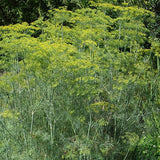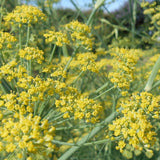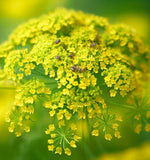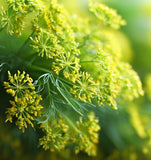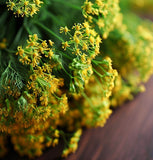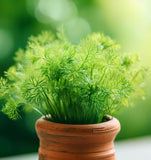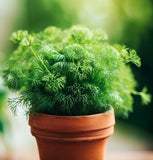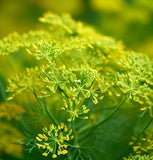Dill, Bouquet (Anethum graveolens)
Dill, Bouquet (Anethum graveolens) is a popular variety of dill known for its delicate foliage and strong aromatic qualities. It is an herb from the Apiaceae family, and its feathery leaves and seeds are widely used in cooking and pickling.
Appearance: Dill, Bouquet plants typically grow to a height of about 2 to 3 feet (60 to 90 cm). It has finely divided, fern-like leaves that are bright green in color. The leaves grow on slender stems, giving the plant an airy and elegant appearance. Dill produces clusters of small yellow flowers that eventually develop into seeds.
Culinary uses: Both the leaves and seeds of Dill, Bouquet are used in culinary applications. The leaves have a fresh, grassy flavor with a hint of anise and are commonly used as a seasoning or garnish in various dishes. They are particularly popular in Scandinavian, Eastern European, and Mediterranean cuisines. Dill leaves are often added to salads, dressings, sauces, soups, seafood dishes, and pickles. The seeds have a stronger flavor and are used in pickling recipes, bread, and certain spice blends.
Growing requirements: Dill, Bouquet is relatively easy to grow and thrives in full sun or partial shade. It prefers well-drained soil and regular watering to maintain moisture. Dill is an annual herb that readily self-seeds, meaning it drops its own seeds for future growth. It is commonly grown from seeds, which can be sown directly into the garden or started indoors and transplanted. Adequate spacing and thinning of plants can promote healthy growth and prevent overcrowding.
Cultivation: Dill, Bouquet can be cultivated in vegetable gardens, herb gardens, or containers. It is a cool-season herb that can be planted in the spring after the threat of frost has passed. The plants grow relatively quickly, and harvesting can be done by snipping off the fresh leaves as needed. For seed production, allow the flowers to fully mature and dry on the plant before collecting the seeds.
Health benefits: Dill is known for its potential health benefits. It contains vitamins, minerals, and antioxidants that may contribute to overall well-being. Dill is believed to aid digestion, reduce bloating, and have antimicrobial properties. It is also considered a good source of dietary fiber.
Dill, Bouquet, with its delicate foliage and distinct aroma, is a favored variety among gardeners and cooks worldwide. Whether used fresh or dried, its unique flavor enhances a wide range of dishes, particularly those with fish, salads, dressings, and pickles. Its versatility and fresh appeal make it a versatile herb in the kitchen.
Botanical name : Anethum graveolens
Common name : Dill, Bouquet
Life cycle : Annual
Days to maturity : 60
Light requirement : Full sun
Planting time : Spring/Summer
Sowing method : Direct sow
Planting depth : ¼”- ½”
Plant spacing : 8"-12"
Ships : Year-round
Average seed per ounce : Approx. 20,000









